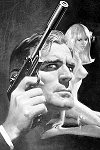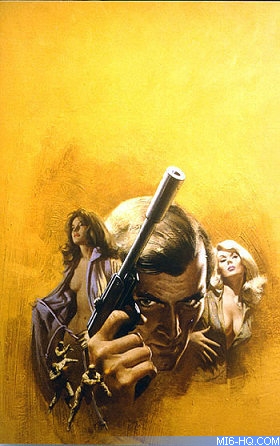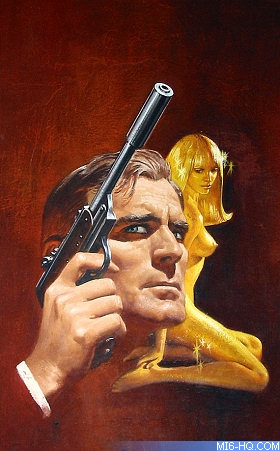 |
| |
Major R F Hall looks back at the inspiration Ian
Fleming had for his creation - Bond, James Bond...
|
|
James Bond - The Origin of the Legend
5th August 2005
In 1935, Fitzroy Maclean was Third Secretary at the embassy
in Paris. On New Year’s Day Sir George Clark threw a luncheon
party in the residence for all the members of the British Mission.
Fitzroy was seated next to a dazzling, lavishly dressed American
blonde. He asked her what she did and she replied that her husband
was a clerk in the Passport Control Office. She introduced him
to her husband and the couple invited him to dinner a week later.
June Dunderdale née Morse, had been a vendeuse at Malbêche
and was the grand-daughter of the inventor of the Morse code;
her husband was Commander Wilfred Dunderdale (who later took part
in covert Naval missions in France).
Dinner proved to be an eye-opener for the young diplomat. The
Dunderdales lived in a magnificent first-floor flat near the Eiffel
Tower, with a vast marble entrance hall. Twenty-four sat down
to dinner, and champagne flowed. After dinner Dunderdale took
his guests to a night club run by an émigré Czarist
general. The general greeted Dunderdale effusively. ‘This
is my friend Maclean’, said Dunderdale. ‘He must have
free champagne whenever he comes here’.
| The party stayed in the night club until
dawn. Then Dunderdale suggested a boat trip down the Seine.
Fitzroy thought he meant a báteau mouche, but when
they arrived at the Seine, there was a private cruiser,
all mahogany and brass. The company was piped aboard in
great style. ‘More champagne, with dawn coming up
- I thought I really am seeing life’.
Stumbling, bleary-eyed, into his office, Fitzroy encountered
the military attaché, related his adventures and
speculated how a mere clerk could afford such a life-style.
The attaché laughed. ‘Don’t you know
what the Passport Control Office is? Standard euphemism
for SIS. Since Fitzroy has sometimes been identified as
Ian Fleming’s model for James Bond it is nice to know
how he met the man who really was.
Dunderdale was born is Odessa of British parents and splice
Russian like a native. He was a spy who had joined the SIS
from naval intelligence in Constantinople in 1924. From
1925 to 1939 he was SIS representative in Paris. It is possible
that the glamorous June was an even bigger asset to the
British Secret Service than Dunderdale himself; hence Bond’s
gorgeous girls and lavish lifestyle.
|
|
 |
In 1940 Fitzroy paid a visit to Dunderdale in Paris and found
him destroying papers and packing up his office.
On 17 March, Robert Bruce Lockhart (Deputy under-secretary at
the FO and Director General of the Political Warfare Executive
from 1941 to 1945) had Fitzroy and Ian Fleming to lunch and again,
after the fall of France, with Dunderdale and Peter Fleming as
well. The genesis of James Bond was in progress. With the characters
of Dunderdale and Fitzroy only a name was missing. This was taken
from an SIS officer called Rodney Bond who operated in Crete in
1941. Peter suggested this name to Ian. During the war Ian Fleming
was PA to the Director of Naval Intelligence with the rank of
Commander. He also ran a unit called ’30 AU’ a RN
Commando to gather naval intelligence from D Day onwards. He was
a good PA but had Buchanesque leanings and ‘Boys Own’
ideas and fanciful opinions of himself. He was a dedicated gambler
and smoked special cigarettes in a ‘Noel Coward’ type
holder.
 |
|
Camp X (STC103, the Canadian/ American equivalent
of Inverailort)
While in Canada in 1942 Fleming met ‘Little Bill’
Stephenson, who ran the British Security Co-ordination,
and introduced him to ‘Big Bill’ Donovan, who
ran the Office of Strategic Services. Together they had
formed Camp X.
Fleming is reported to have been on a course there and
passed ‘First Class’. He never did! He must
have got his knowledge of what the courses were like from
them and from his brother Peter, who had been at Inverailort
(STC 101) and who was in SOE Middle East. He was fascinated
by all the ‘gadgets’, especially the underwater
ones and the ‘thuggery’ taught.
‘M’. Colin Gubbins was the originator of the
British Resistance Organisation, SOE, and other top secret
movements. His full name was Colin Mcveigh Gubbins and he
signed his letters ‘M’. He could not use ‘C’
as this was the letter used by the head of SIS, and ‘G’
was in common use in the army. Peter Fleming was one of
Gubbin’s men. Ian stole the ‘M’ for James
Bond’s controller! 007 is an invention of Ian Fleming’s.
Agents are known by code names not numbers.
|
Felix Leiter. In America Fleming had a good influential friend
who helped him in his writing career. Her name was Marion ‘Oatsie’
Leiter. He used her surname for Bond’s CIA ally.
Ian’s ambition always had been to be an author. When he
retired to Jamaica after the war he lived in a house called ‘Goldeneye’
and in the library there he found a copy of a book called ‘Birds
of the West Indies’ by James Bond! This discovery confirmed
the name of his hero, and his first book was called ‘Casino
Royale’. All his books and films contain all the features
he had been told about tinged by his own personality - spying,
gorgeous girls, under-water, skulduggery - and gambling!
Ian Fleming wrote fourteen books in all. After his death in 1964,
Glidrose commissioned Kingsley Amis, John Gardner and Raymond
Benson to carry on the book tradition. Gardner wrote fourteen
titles and mentions more techniques taught at STC that Fleming
had never heard of! For example - the Fairbairn/Sykes ‘Double
Tap’. ‘Dan’ Fairbairn and ‘Bill’
Sykes were close combat and silent killing instructors at STC
101. They invented the well known double-edged Commando knife
and taught the ‘Double Tap’ - firing two shots
together with a 9mm handgun or weapon to be sure to stop and kill.
Sykes stayed at STC101 to teach SOE, Fairbairn went to STC 103
in March 1942 to teach their methods to the Canadians and Americans.
“My name is Bond, James Bond”
Article by Major R F “Henry”
Hall.
Major Hall has taken part and contributed to various documentary
films on the 'Big House' Inverailort (STC 101), and the secret
army of WWII.